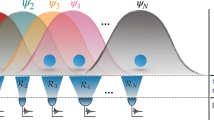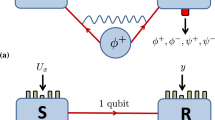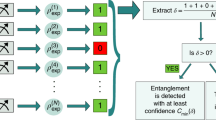Abstract
Entanglement is a necessary resource for quantum applications—entanglement established between quantum systems at different locations enables private communication1 and quantum teleportation2, and facilitates quantum information processing3. Distributed entanglement is established by preparing an entangled pair of quantum particles in one location, and transporting one member of the pair to another location. However, decoherence during transport reduces the quality (fidelity) of the entanglement. A protocol to achieve entanglement ‘purification’ has been proposed4 to improve the fidelity after transport. This protocol uses separate quantum operations at each location and classical communication to distil high-fidelity entangled pairs from lower-fidelity pairs. Proof-of-principle experiments distilling entangled photon pairs have been carried out5,6,7,8,9. However, these experiments obtained distilled pairs with a low probability of success and required destruction of the entangled pairs, rendering them unavailable for further processing. Here we report efficient and non-destructive entanglement purification4 with atomic quantum bits. Two noisy entangled pairs were created and distilled into one higher-fidelity pair available for further use. Success probabilities were above 35 per cent. The many applications of entanglement purification make it one of the most important techniques in quantum information processing.
This is a preview of subscription content, access via your institution
Access options
Subscribe to this journal
Receive 51 print issues and online access
$199.00 per year
only $3.90 per issue
Buy this article
- Purchase on Springer Link
- Instant access to full article PDF
Prices may be subject to local taxes which are calculated during checkout


Similar content being viewed by others
References
Ekert, A. K. Quantum cryptography based on Bell's theorem. Phys. Rev. Lett. 67, 661–663 (1991)
Bennett, C. H. et al. Teleporting an unknown quantum state via dual classical and Einstein-Podolsky-Rosen channels. Phys. Rev. Lett. 70, 1895–1899 (1993)
Gottesman, D. & Chuang, I. L. Demonstrating the viability of universal quantum computation using teleportation and single-qubit operations. Nature 402, 390–393 (1999)
Bennett, C. H. et al. Purification of noisy entanglement and faithful teleportation via noisy channels. Phys. Rev. Lett. 76, 722–725 (1996)
Kwiat, P. G., Barraza-Lopez, S., Stefanov, A. & Gisin, N. Experimental entanglement distillation and ‘hidden’ non-locality. Nature 409, 1014–1017 (2001)
Pan, J-W., Gasparoni, S., Ursin, R., Weihs, G. & Zeilinger, A. Experimental entanglement purification of arbitrary unknown states. Nature 423, 417–422 (2003)
Yamamoto, T., Koashi, M., Özdemir, S. K. & Imoto, N. Experimental extraction of an entangled photon pair from two identically decohered pairs. Nature 421, 343–346 (2003)
Zhao, Z., Yang, T., Chen, Y-A., Zhang, A-N. & Pan, J-W. Experimental realization of entanglement concentration and a quantum repeater. Phys. Rev. Lett. 90, 207901 (2003)
Walther, P. et al. Quantum nonlocality obtained from local states by entanglement purification. Phys. Rev. Lett. 94, 040504 (2005)
Quantum Information Science and Technology Experts Panel. ARDA quantum information science and technology roadmap. 〈http://qist.lanl.gov〉 (2002)
Browne, D. E. & Rudolph, T. Resource-efficient linear optical quantum computation. Phys. Rev. Lett. 95, 010501 (2005)
Eisert, J., Jacobs, K., Papdopoulos, P. & Plenio, M. B. Optimal local implementation of nonlocal quantum gates. Phys. Rev. A 62, 052317 (2000)
Brennen, G. K., Song, D. & Williams, C. J. Quantum computer architecture using nonlocal interactions. Phys. Rev. A 67, 050302 (2003)
Knill, E. Quantum computing with realistically noisy devices. Nature 434, 39–44 (2005)
Barrett, M. D. et al. Deterministic quantum teleportation of atomic qubits. Nature 429, 737–739 (2004)
Leibfried, D. et al. Experimental demonstration of a robust, high-fidelity geometric two ion-qubit phase gate. Nature 422, 412–415 (2003)
King, B. E. et al. Cooling the collective motion of trapped ions to initialize a quantum register. Phys. Rev. Lett. 81, 1525–1528 (1998)
Ozeri, R. et al. Hyperfine coherence in the presence of spontaneous photon scattering. Phys. Rev. Lett. 95, 030403 (2005)
Barrett, M. D. et al. Sympathetic cooling of 9Be+ and 24Mg+ for quantum logic. Phys. Rev. A 68, 042302 (2003)
Wineland, D. J. et al. Experimental issues in coherent quantum-state manipulation of trapped atomic ions. J. Res. Nat. Inst. Stand. Technol. 103, 259–328 (1998)
Efron, B. & Tibshirani, R. J. An Introduction to the Bootstrap (Chapman & Hall, New York, 1993)
Lvovsky, A. I. & Raymer, M. G. Continuous-variable optical quantum state tomography. Preprint at 〈http://www.arXiv.org/quant-ph/0511044〉 (2005)
Acknowledgements
This work was supported by the Disruptive Technology Office (DTO), by a DoD Multidisciplinary University Research Initiative (MURI) programme administered by the Office of Naval Research and by NIST. R.R. was supported by the Alexander von Humboldt Foundation. We thank S. Glancy and W. Itano for comments on the manuscript.
Author information
Authors and Affiliations
Corresponding author
Ethics declarations
Competing interests
Reprints and permissions information is available at www.nature.com/reprints. The authors declare no competing financial interests.
Rights and permissions
About this article
Cite this article
Reichle, R., Leibfried, D., Knill, E. et al. Experimental purification of two-atom entanglement. Nature 443, 838–841 (2006). https://doi.org/10.1038/nature05146
Received:
Accepted:
Issue Date:
DOI: https://doi.org/10.1038/nature05146
This article is cited by
-
Advances in quantum entanglement purification
Science China Physics, Mechanics & Astronomy (2023)
-
Towards entanglement distillation between atomic ensembles using high-fidelity spin operations
Communications Physics (2022)
-
Entanglement purification for memory nodes in a quantum network
Science China Physics, Mechanics & Astronomy (2020)
-
Effect of weak measurement on entanglement distribution over noisy channels
Scientific Reports (2016)
-
Matching relations for optimal entanglement concentration and purification
Scientific Reports (2016)
Comments
By submitting a comment you agree to abide by our Terms and Community Guidelines. If you find something abusive or that does not comply with our terms or guidelines please flag it as inappropriate.



